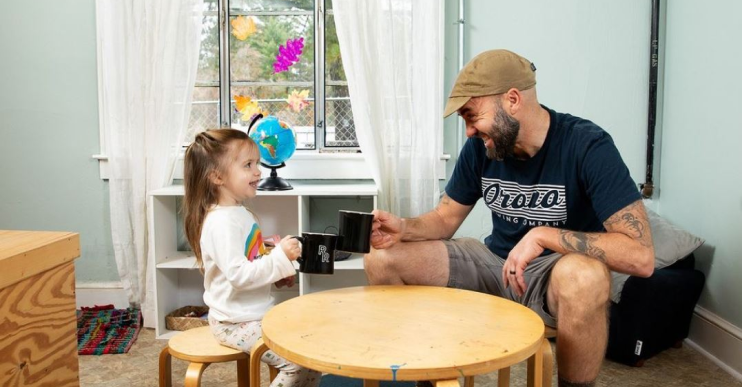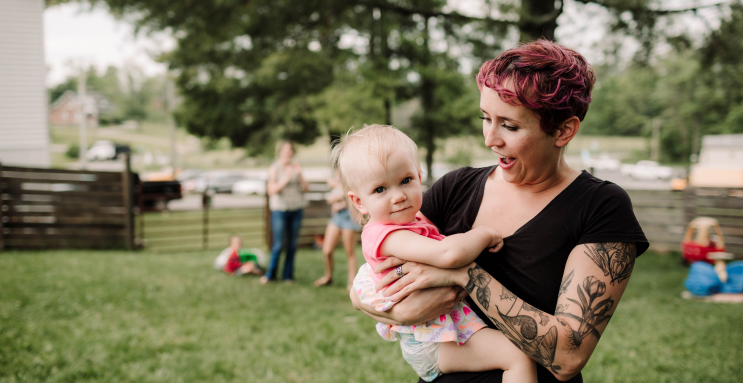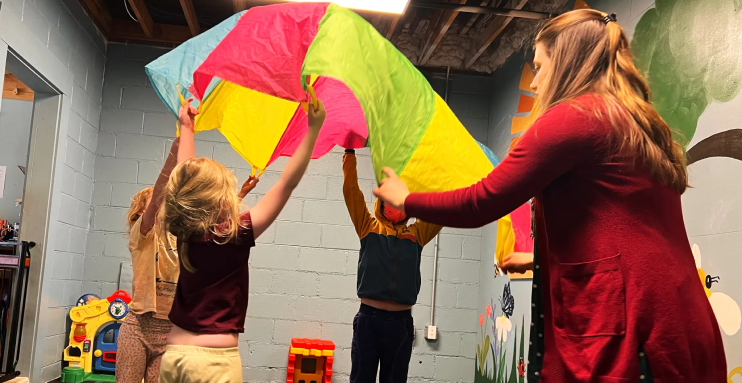“With on-site childcare, the presence of children is part of the culture and everyone knows everyone else’s kids. The connections among the children are almost spiritual. It’s something you can’t really put a price on.”
– Haden Polseno-Hensley, Co-Owner, Red Rooster Coffee
Background: A Growing Business Leads to Growing Families
In 2010 in Floyd County, Virginia (pop. 15,500), Haden Polseno-Hensley and Rose McCutchan created Red Rooster Coffee with the simple idea of roasting their own coffee for their small, family-owned shop. But as word of their exquisitely roasted beans spread, demand rose and Red Rooster grew into a team of nearly 50 people, roasting coffee not only for the cafe but for robust wholesale and subscription sales.
Alongside the thriving business came growing families. As parents themselves, Polseno-Henlsey and McCutchan clearly understood the barriers to finding accessible, affordable child care in the area. They knew that finding a way to offer child care was critical to upholding their company values and fulfilling their goal to make Red Rooster an economic and social anchor in their rural community.
Solution: From a Shared Babysitter to a Child Care Center
The need for a child-care solution was personal: Polseno-Hensley and McCutchan couldn’t manage their business without care for their two-year-old. So, they teamed up with a friend who had a child the same age and hired a babysitter to watch both children in an extra room in Red Rooster’s office. Then, one of Red Rooster’s team members announced a new pregnancy. Polseno-Hensley said, “It was like a spiral from there. The same thing happened with another person, so there were four children that needed care, and then five.”
With the growing number of children and pregnant staff asking for child care, they knew they needed to act. “[In finding a solution,] we knew we wanted to prioritize our values: ‘Taking Good Care of Our Coffee, Our People, Our Farmers, Our Planet,’” said Polseno-Hensley.
On-Site Child Care Center ‘Yellow Hen’ Comes to Life
They had the space, so Red Rooster’s owners opted to keep their child care on site. Recognizing their expertise was in coffee, not child care, and that they would need more than a single provider, Polseno-Hensley identified a local educator who would become the director of the child-care center, overseeing the licensing, hiring, day-to-day management and providing the necessary expertise in early childhood education.
The Red Rooster team took care of the space, leveraging 1,000 square feet within their operations building. (Fortunately, they had planned ahead for appropriate plumbing and electrical.) The on-site child care center, Yellow Hen, officially opened its doors in June 2018. Within a year, the center was at capacity.
Today, Yellow Hen employs six part-time educators who provide care from 8:30 a.m. to 6 p.m. for 16 to 18 children on varying schedules. The center cares for children ages six weeks to five years old during the school year and expands to care for kids up to 10 years old during the summer.
Results: On-Site Child Care Brings Retention and Recruitment Wins
Child Care Center Retains Employees and Leaders
Floyd County is among the most rural counties in Virginia. The town of Floyd, which Red Rooster calls home, has a population of about 500. Attracting talent to this remote corner of the state is “very difficult,” according to Polseno-Hensley. So, when you find talent like Indya DiPietro, manager of Red Rooster’s coffee shop, it’s a big deal. “She’s an incredibly skilled manager with an innate talent for being able to address things people are doing wrong in a way that’s not confrontational and can maintain a positive relationship with that person,” Polseno-Hensley said. DiPietro’s eight-year-old daughter was one of Yellow Hen’s first children, and has attended the center for five years, allowing DiPietro to commit to Red Rooster and grow her talents in management.
Polseno-Henlsey credits the on-site child care for being part of the reason for keeping his exceptional long-term employees: “We are a 14-year-old company and have people who have worked for us for 10 of those years. I attribute some of that to the child care center. This allows work to happen in a frictionless way.”
Child Care Option Attracts Top Talent
Polseno-Hensley also speaks to the value of child care in recruiting top talent: “I have employees who only work here because of the access to care. They are good employees and we are happy to have them, but the reason they came is because we offer child care.
“We’ve invested a ton of time and money into our staff to make them coffee experts in a region where you’d have to go 100 miles to find anyone else with the experience and skills of some of our top staff,” Polseno-Hensley told Daily Coffee News by Roast Magazine. “I want those people working for me forever, both because I love them as people and because I’ve invested in them. If they want to have babies, I don’t want that to be a barrier to achieving their career goals.”
Challenges
Polseno-Hensley admits that the most difficult part of offering child care at work is managing the schedule. In order to comply with licensing requirements, they always need to make sure to have the right teacher-to-child ratios. Sometimes employees can’t get the child care they need due to teacher illnesses or vacations. But, “It is still more predictable than other child care options that exist,” says Polseno-Hensley. “And we provide flexibility for our staff based on when they can receive the child care that they need.”
Polseno-Hensley’s Advice to Business Leaders
When considering offering child care, many leaders worry that staff without children will feel neglected. Not so for Red Rooster. Polseno-Hensley states, “It’s never caused tension with my non-parenting employees. I’ve never heard anyone say ‘I could be paid more if we didn’t have the child care center.’”
Polseno-Hensley has three key pieces of advice for employers looking for child care solutions for their business:
First, Believe You Can Do It
“If you’re an under-a -$20M-a -year company, there are a lot of things you deal with that are harder than figuring out a child care solution. If it’s occurring to you, then you should probably pursue it. It comes down to where you invest your money: think about the other things you spend $100k on.”
Second, Find an Expert
“We found Ella, our child care center director, and she did it. We made a lot of cooperative decisions, but she led it all. These people exist and you could provide a great job for someone in a gray area of their career by paying them pretty well and building opportunity for that person as well as your employees.”
Finally, Be Thoughtful About Where You Are in Your Company’s Growth
“I would do it again but we started too early. We weren’t at the size to pay our people an hourly wage that we were satisfied with. Employees only paid $1/hour to send their children to the Yellow Hen and that was a nod to the fact that we weren’t paying them enough. But the business needs to be financially solvent enough to say we are taking care of all employees to the best of our ability and then this is another thing we can add to that.”


